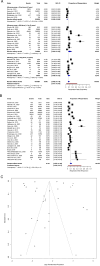Risk Factors and Reoperation Rate in Revision Lumbar Disc Herniation Surgery: A Systematic Review and Meta-Analysis of 1,031,348 Patients
- PMID: 41168979
- PMCID: PMC12578623
- DOI: 10.1177/21925682251392171
Risk Factors and Reoperation Rate in Revision Lumbar Disc Herniation Surgery: A Systematic Review and Meta-Analysis of 1,031,348 Patients
Abstract
Study DesignA systematic review and meta-analysis.ObjectivesTo estimate reoperation rate after lumbar disc herniation surgery and identify associated risk factors.MethodsWe searched PubMed, Cochrane Central Register of Controlled Trials (CENTRAL), Web of Science, Scopus, and Embase to April 2025 for English-language randomized controlled trials and observational studies reporting risk factors and reoperation rates. Two reviewers independently screened studies, extracted data, and assessed quality using the Newcastle-Ottawa Scale and Cochrane Risk of Bias 2.0 tool. Meta-analysis used fixed-effect model.ResultsTwenty-five studies (1,031,348 patients) met the inclusion criteria. The pooled reoperation rate was 8.5% (95% CI: 6.2%-11.6%), rising with follow-up: 4% at ≤1 year, 11.1% at 1-5 years, and 8.8% beyond 5 years (P < 0.0001 for subgroup differences). Smoking (OR 1.39; 95% CI: 1.09-1.78), older age (OR 1.52; 95% CI: 1.25-1.85), and large annular defect size (OR 2.19; 95% CI: 1.07-4.48) were significant risk factors; sex was not (OR 1.22; 95% CI: 0.96-1.55). Diabetes and certain surgical techniques were also linked to higher risk in individual studies. Adjustment for publication bias increased the overall pooled rate to 10.3% (95% CI: 7.6%-14.0%).ConclusionsReoperation rates after lumbar disc herniation surgery differ by follow-up duration: 4% at ≤1 year, 11.1% at 1-5 years, and 8.8% beyond 5 years. Smoking, older age, diabetes, and large annular defects were significant risk factors. Recognizing high-risk patients can support decisions for extended conservative care or closer follow-up. Further studies should compare revision techniques to improve long-term outcomes.
Keywords: lumbar disc herniation; meta-analysis; reoperation; risk factors.
Conflict of interest statement
The authors declared no potential conflicts of interest with respect to the research, authorship, and/or publication of this article.
Figures




References
-
- Al Qaraghli MI, De Jesus O. Lumbar Disc Herniation. Treasure Island (FL): StatPearls Publishing; 2025. - PubMed
-
- Yoon SM, Ahn SS, Kim KH, Kim YD, Cho JH, Kim DH. Comparative study of the outcomes of percutaneous endoscopic lumbar discectomy and microscopic lumbar discectomy using the tubular retractor system based on the VAS, ODI, and SF-36. Korean J Spine. 2012;9(3):215-222. doi: 10.14245/kjs.2012.9.3.215 - DOI - PMC - PubMed
Publication types
LinkOut - more resources
Full Text Sources
Miscellaneous

